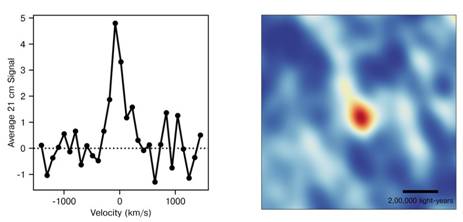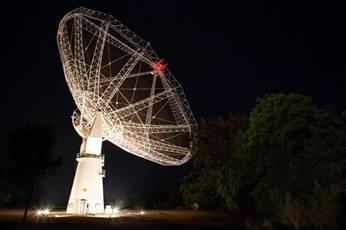Astronomers tracking star formation activity of the young Universe billions of years ago have long been intrigued by the fact that star formation in galaxies which was at its highest about 8-10 billion years ago, had declined steadily thereafter. Searching for the reason behind this, they have found that the likely cause for the decline is that galaxies were running out of fuel.
The fuel critical to hydrogen formation is atomic hydrogen gas content of galaxies. Two studies that measured the atomic hydrogen content 9 billion years ago and 8 billion years ago, respectively, have helped them come to this conclusion.
A team of astronomers from the National Centre for Radio Astrophysics (NCRA-TIFR) in Pune, and the Raman Research Institute (RRI), Bangalore, an autonomous institute of the Department of Science and Technology, used the Giant Metrewave Radio Telescope (GMRT) to measure the atomic hydrogen gas content of galaxies 9 billion years ago. This is the earliest epoch in the universe for which there is a measurement of the atomic hydrogen content of galaxies. The new result is a crucial confirmation of the group’s earlier result, where they had measured the atomic hydrogen content of galaxies 8 billion years ago and pushes our understanding of galaxies to even earlier in the universe. The new research has been published in the 2 June 2021 issue of The Astrophysical Journal Letters.
Aditya Chowdhury, a Ph.D. student at NCRA-TIFR and the lead author of both the new study and 2020 one, said, “Our new results are for galaxies at even earlier times, but still towards the end of the epoch of maximum star-formation activity. We find that galaxies 9 billion years ago were rich in an atomic gas, with nearly three times as much mass in atomic gas as in stars. This is very different from galaxies today like the Milky Way, where the gas mass is nearly ten times smaller than the mass in stars.”
The measurement of the atomic hydrogen gas mass was done by using the GMRT to search for a spectral line in atomic hydrogen, which can only be detected with radio telescopes.
“The observations of our study were carried out around 5 years ago, before the GMRT was upgraded in 2018. We used the original receivers and electronics chain of the GMRT before its upgrade,” said Nissim Kanekar of NCRA-TIFR, a co-author of the study.
Barnali Das, another Ph.D. student of NCRA-TIFR, added, “However, we increased our sensitivity by observing for longer, with nearly 400 hours of observations generating large volume of data.”
“The star formation in these early galaxies was so intense that they would consume their atomic gas in just two billion years. And, if the galaxies could not acquire more gas, their star formation activity would decline and finally cease,” said Chowdhury. “It thus appears likely that the cause of the declining star- formation in the Universe is simply that galaxies were not able to replenish their gas reservoirs after some epoch, probably because there wasn’t enough gas available in their environments,” headed.
“With the present result, using a completely different set of receivers and electronics, we now have two independent measurements of the atomic hydrogen gas mass in these early galaxies,” Kanekar pointed out.
K. S. Dwarakanath of RRI, who along with Shiv Sethi, were co-authors of the study, stressed, “Detecting the 21 cm signal from distant galaxies was the main original goal of the GMRT and continues to be a key science driver for building even more powerful telescopes like the Square Kilometre Array. These results are extremely important for our understanding of galaxy evolution.”
The research was funded by the Department of Atomic Energy, India, and the Department of Science and Technology, India.
Publication link:
(https://iopscience.iop.org/article/10.3847/2041-8213/abfcc7).
Contacts:
Aditya Chowdhury (chowdhury@ncra.tifr.res.in ; 97651 15719),
Nissim Kanekar (nkanekar@ncra.tifr.res.in ; 9975077018),
Barnali Das (barnali@ncra.tifr.res.in),
K.S. Dwarakanath (dwaraka@rri.res.in),
Shiv Sethi (sethi@rri.res.in ; 94825 70297),
Yashwant Gupta (ygupta@ncra.tifr.res.in ; 020 – 2571 9242)
C. H. Ishwara-Chandra (ishwar@ncra.tifr.res.in; 020 – 2571 9228),
J. K. Solanki (solanki@ncra.tifr.res.in; 020 – 2571 9223).
Anil Raut: (anil@gmrt.ncra.tifr.res.in ; 86055 25945)

Caption: The two panels show the detected GMRT 21cm signal as a spectrum (left panel) and an image (right panel).

Caption: A GMRT antenna at night (Picture credit: Rakesh Rao)
*********************************************
SS/RP/ (DST Media Cell)
(Release ID: 1724108)
Visitor Counter : 1
Read this release in:
Tamil


